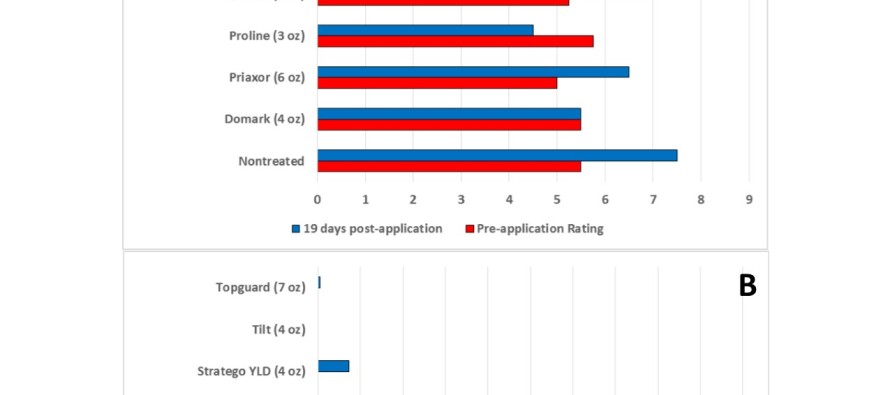Frogeye Leaf Spot Fungicide Preliminary Data (Updated 8/30/2013)

 Written by: Tom Allen, Tessie Wilkerson, and Trent Irby
Written by: Tom Allen, Tessie Wilkerson, and Trent Irby
Please view the included data as extremely preliminary. Generally speaking, regardless of product frogeye leaf spot tended to appear worse following the fungicide application. Increased disease severity following a fungicide application is not uncommon and can make some fungicides appear to not be effective at managing a specific foliar disease. However, yield data will be the most important part to determine how products are managing the disease and preventing yield loss as a result of frogeye leaf spot.
Over the past several weeks we’ve received numerous phone calls regarding the best fungicide products for managing frogeye leaf spot. Most calls have been due to a susceptible soybean variety having received either a stand-alone strobilurin fungicide at a reduced rate (4 fl oz/a versus 6 fl oz/a) or whether or not a second fungicide application might be necessary following a fungicide application that didn’t appear to prevent frogeye from increasing. Making the case for a second fungicide application can be difficult especially since most of the varieties that appear to be extremely susceptible to frogeye are great yielders.
Several trials have been established this season at different growth stage timings to determine the best fungicide management program for frogeye leaf spot in susceptible varieties. Two main locations have been used for some “late†fungicide applications: Starkville and Stoneville.
In Starkville: Due to space limitations the fungicide trial contained nine fungicide treatments and a non-treated check. Applications were made at R5 to Armor DK 4744 (frogeye susceptible) and the presence of frogeye was rated immediately prior to application and 19 days post-application. Frogeye was rated on a general 0-9 scale (0= no disease and 9=extreme disease with blighting of foliage). In addition to rating for the presence and severity of frogeye leaf spot, fungicide phytotoxicity was also scored in each plot on a 0-100% scale. The third rating will be conducted on 8/29/2013 with updated information to follow. (Starkville frogeye rating charts)
In Stoneville: A similar fungicide trial was conducted, but we were able to include 14 treatments with a non-treated check. Plots were rated prior to application and fungicides were applied at R5.5 to Armor DK 4744. Similar to the Starkville trial, frogeye leaf spot and phytotoxicity were rated 14 and 21 days post-application. (Stoneville frogeye rating charts)
As a brief summary, frogeye leaf spot incidence increased post-application regardless of product applied. However, some fungicides appear to have done a better job limiting the spread of frogeye to non-infected plant tissue. Similar to what has occurred in some field situations across MS, phytotoxicity was observed following the application of particular products with triazole ingredients known to result in phytotoxicity. In addition, similar to reports and observations made in commercial field situations, phytotoxicity of products increased over time. One interesting thing to point out has to do with the performance of stand-alone strobilurin products. In the past, the stand-alone strobilurins did an excellent job of limiting frogeye leaf spot disease increase. However, based on the data from the Stoneville location (3 disease ratings), it appears that stand-alone strobilurin fungicides aren’t holding the frogeye as well as in the past. But, until we have a laboratory indication of widespread strobilurin-resistant isolates in MS we are not prepared to refer to this as resistance. With regards to the phytotoxicity, in some instances (specifically with Proline), rating frogeye leaf spot was difficult due to the level of phytotoxicity present so in instances where it appears there was less frogeye post-application consider the amount of leaf damage present with this particular chemistry. Even though the fungicide (Proline) is a good product, the triazole chemistry can produce extensive foliar phytotoxicity symptoms masking the presence and severity of the disease.
Additional fungicide trials were sprayed on double-crop soybean plots (Armor DK 4744) to determine if Stratego YLD alone is producing phytotoxicity or an adjuvant is more to blame. Trials were sprayed yesterday (8/28/2013) on R5 soybean plots at several different rates (4, 4.5, and 4.65 fl oz/a) with NIS and COC (@ 0.125% and 0.25% v/v) as well as a non-treated check and a Proline application (3 fl oz/a) that appears to produce more intense phytotoxicity (see attached figures).




Let me tell You a sad story ! There are no comments yet, but You can be first one to comment this article.
Write a comment